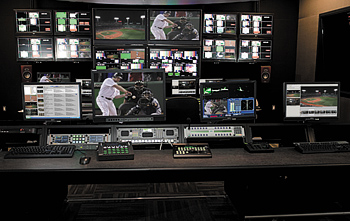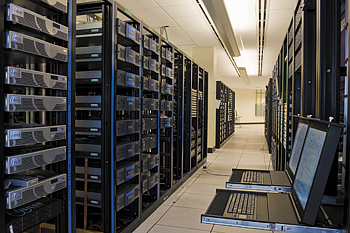Fox Sports Upgrades Houston Net
HOUSTON Big. That is the only word that accurately describes Fox Sports Net's new all 720p HD Network Center facility in Houston. Designed by Fox to ingest live broadcasts for 22 full-time networks—including Fox's 15 regional sports networks—and distributing them nationwide, Fox Network Center-Houston (FNC-Houston) is a facility approaching 200,000 square feet in size that contains 31 master control rooms, plus technical and staff areas.
The new FNC-Houston facility replaces Fox's 25 year-old Houston Technical Operations Center. FNC-Houston also serves as a backup to the Fox Network Center in Los Angeles. FNC-Houston was built by AZCAR Technologies, a systems integrator headquartered in Markham, Canada.

For FNC-Houston, AZCAR built 31 master control rooms, organized into "pods" to share resources.
"We designed this many master control rooms to integrate all the live events we receive from our production teams at the games," said Tim Sweeney, FNC-Houston GM. "On a busy day, we handle up to 40 live games; that's a volume of activity that no other facility in the country is called upon to broadcast. Our facility receives these events primarily via Level 3 fiber or satellite, adds commercials and graphics, then sends them out via satellite or in some cases fiber to the appropriate cable headends throughout the country, plus the Verizon, AT&T, DirecTV and Dish networks." And FNC-Houston has the space to double its capacity, according to Sweeney.
MASTER CONTROL PODS
Each FNC-Houston master control room is designed to operate as a standalone facility. For efficiency's sake, and to share resources where practical, the master control rooms are organized into groups known as "pods." A typical pod contains eight standalone master control rooms.
"The pod is manned by both operators and supervisors," Sweeney said. At the center of each pod are multicast positions capable of handling up to 16 signals at a time.
"Each FNC-Houston master control is built around an Evertz QMC Master Control Switcher equipped with a Quartz Media Graphics processor," said Mike Walter, AZCAR's lead engineer on the project. "Each QMC switcher is fed by a smaller Xenon router; there are two Xenon routers in each of the pods. Evertz routing equipment is used within each master control to move the signals around."

AZCAR Fox Er101 Core Nexio Server System Any required graphics, including bottom-third text and crawls, are composed and sourced from a Chyron HD/SD graphics system. The feeds themselves are viewed on Sony LCD large format displays, and then distributed through the large core Evertz EQX routers to one of many compression chains for uplink or for distribution to other Fox sites via a Harris NetVX-based internal network.
BACK TO BIG
To illustrate how truly "big" the revamped FNC-Houston facility, here are some stats to back it up:
- 3 million feet of cable;
- 2,744 GigE ports;
- 60 satellite ingest channels/120 satellite return channels.
FNC-Houston's transmission gear includes 720p HD MPEG-2 compression equipment, multiplexers and uplinks that can illuminate five satellites with more than 60 720p HD streams, fully backed up. "That includes backup facilities to cover Fox's Los Angeles cable channels and broadcast network," Walter said. In a nutshell, "this was a huge installation in a huge building; one that required up to 30 installers on site during peak periods."
TWO-YEAR PROJECT
From start to finish, it took two years to build FNC-Houston. Fox began transferring its feeds in phases from the Houston Technical Operations Center to FNC-Houston in early 2008, to minimize the chance of things going wrong.
"There were times where the feeds were coming into the old Operations Center for packaging, then being patched over to the new FNC-Houston for distribution," said Walter. "It was a real complex effort, with Fox having to coordinate staff between the two locations."
A lot of troubleshooting was required to make everything work as planned. Because FNC-Houston is so big, "scalability was an issue," Sweeney said. "To get all of this equipment to talk to each other was not easy."
Adding to the challenge was the fact that much of the installed equipment was so new. A lot of it is first generation or even the very first of its kind, simply because Fox's engineers designed this facility to be as "future-proof" as possible.
"Getting cutting-edge equipment to work properly is always a challenge," said Walter. "Getting 40-50 pieces of first generation equipment to work together; well that's just plain fun."
Despite the challenges, Fox and AZCAR succeeded in getting FNC-Houston fully online on May 1, 2008. "Things are working well," Sweeney said. "In fact, we remained fully operational during Hurricane Ike, and handled 19 live events through our facility that day."
The professional video industry's #1 source for news, trends and product and tech information. Sign up below.
